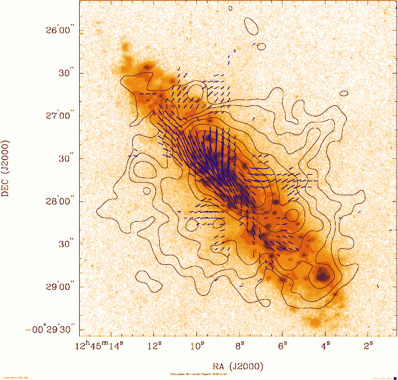
Starbursts and superwinds
DR EMILY BALDWIN
ASTRONOMY NOW
Posted: 02 September 2010


A new visible light image from ESO captures a galaxy bursting with star formation and expelling a 'superwind' of gas.

This visible light image was made with the Wide Field Imager on the MPG/ESP 2.2 metre telescope at La Silla Observatory in Chile. Intense star formation is likely due to the interaction with NGC 4668 seen to the lower left. Image: ESO/J. Dietrich.
Previously observed in X-rays by ESA's XMM Newton space telescope, the visible light view taken with the Wide Field Imager on the MPG/ESO 2.2 metre telescope at the La Silla Observatory adds further detail to NGC 4666, which is located 80 million light years from Earth. Gravitational interactions with neighbouring galaxies, including NGC 4668 in the lower left of the image, likely sparked the galaxy's frenetic star formation.

Hot gas (orange tones) and magnetic fields (blue lines) in galaxy NGC 4666. X-ray emitting hot gas is observed above the most active star-formation regions in the galaxy's disc alongside magnetic field structures. Image: M. Ehle and ESA.
Deep within the starburst region a combination of supernova explosions and strong winds from massive stars drives a torrent of gas out into space for tens of thousands of light years. Extremely hot, this 'superwind' glows in X-rays and radio wavelengths, which cannot be seen in the visible light images.
|



